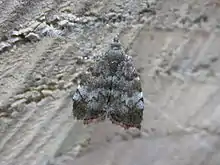Choreutis pariana
Choreutis pariana, the apple-and-thorn skeletonizer or apple leaf skeletonizer, is a moth of the family Choreutidae. The moth was first described by the Swedish entomologist Carl Alexander Clerck in 1759. It is native to Eurasia and was introduced to New England, USA in 1917.
| Choreutis pariana | |
|---|---|
 | |
| Scientific classification | |
| Kingdom: | |
| Phylum: | |
| Class: | |
| Order: | |
| Family: | |
| Genus: | |
| Species: | C. pariana |
| Binomial name | |
| Choreutis pariana | |
| Synonyms | |
| |
Physical characteristics
The wingspan is 11–15 mm.[2] The forewings are pale smeared brown, with a coppery sheen. The inner half and terminal area are usually darker brown. The antemedial line is dark brown and jagged, and is usually only distinctive in the upper two thirds. The postmedial line is less obvious, paler brown, jagged and usually only upper two thirds are obvious. Occasionally, the other lines are visible, but never as obvious as the antemedial line. There are four small whitish rectangles visible along the costa at the antemedial line, median, and postmedial line. The fringe is brown with two thin pale patches along the outer edge on either side of the middle. The hindwings are warm brown, but slightly darker towards the outer margin. The fringe is brown, but paler at the anal angle and apex. The body is dark brown.[3]
Life cycle
The larvae feed, under a fine silken web on the upperside of a leaf, eating the parenchyma, except for the lower cuticle, which is left as a brown blotch resulting in a skeleton leaf appearance.[4] Larvae are found on crab apple (Malus pumila), hawthorn (Crataegus species), paper birch (Betula papyrifera), willow (Salix species), cherry (Prunus species), whitebeam (Sorbus species), ash (Fraxinus species), rose (Rosa species) and alder (Alnus species). Larvae have been recorded from June to early September in North America, while in Britain they are found in May and June and again in August. Larva pupate in a whitish, silk cocoon 15–20 mm long, usually on the underside of a leaf'.[4]
In Canada, adults have been recorded from late July to late October. There are two generations per year in western Europe, with adults on wing in July and again in September, when it overwinters and may appear again in early spring.[2]
Distribution
The apple leaf skeletonizer is found in Asia and Europe from Japan to Ireland and was introduced to New England in 1917.[4] It is frequently collected in agricultural areas in North America where it is found along the west coast of the United States and British Columbia, Ontario, New Brunswick, Nova Scotia, Prince Edward Island and Newfoundland and Labrador.
References
- "Choreutis pariana (Clerck, 1759)". Fauna Europaea. Retrieved 30 October 2020.
- Kimber, Ian. "Apple Leaf Skeletonizer Choreutis pariana (Clerck, 1759)". UKmoths. Retrieved 30 October 2020.
- "The Metalmark Moths (Lepidoptera: Choreutidae) Of Ontario" (PDF). Archived from the original (PDF) on 2012-03-20. Retrieved 2011-12-19.
- Pelham-Clinton, E C (1985). Heath, John; Emmet, A Maitland (eds.). The Moths and Butterflies of Great Britain and Ireland. Volume 2. Colchester: Harley Books. pp. 397–8. ISBN 0 946589 19 4.
